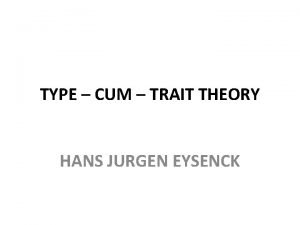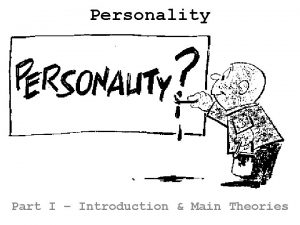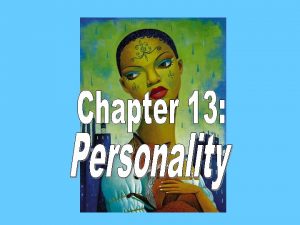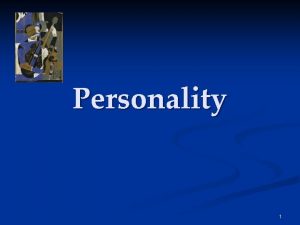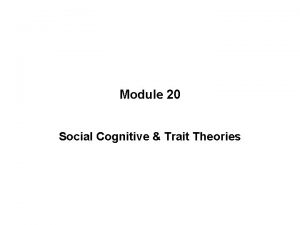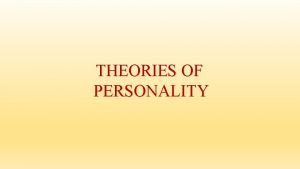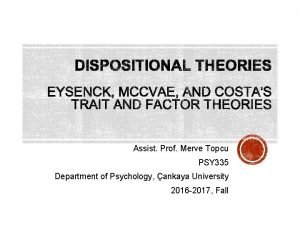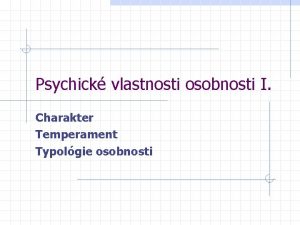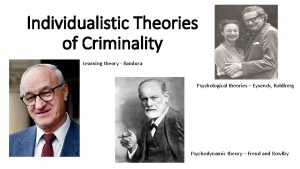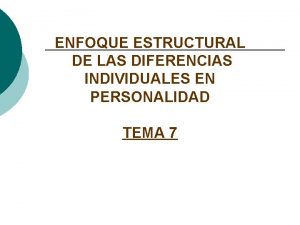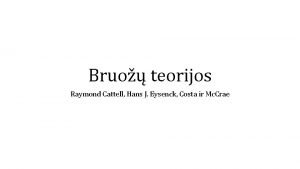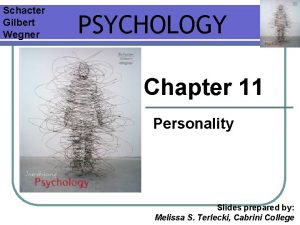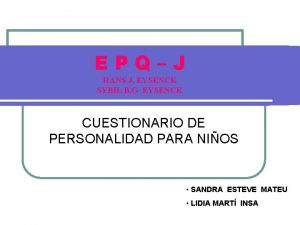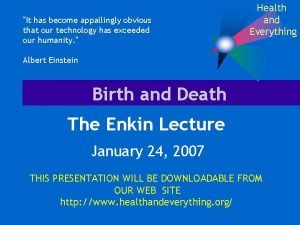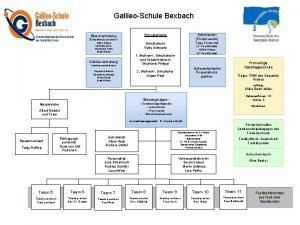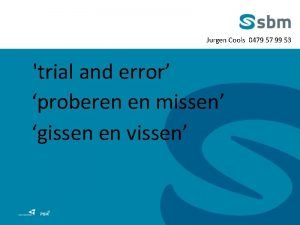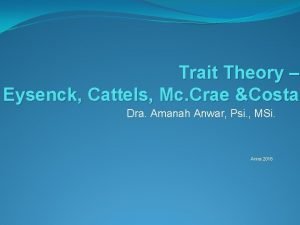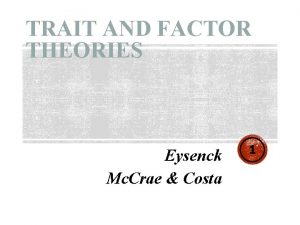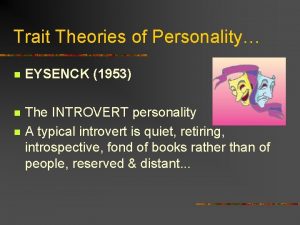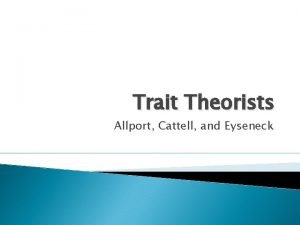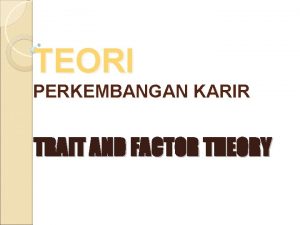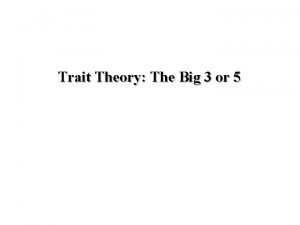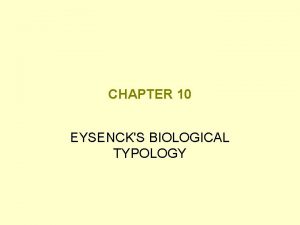TYPE CUM TRAIT THEORY HANS JURGEN EYSENCK HANS

























- Slides: 25

TYPE – CUM – TRAIT THEORY HANS JURGEN EYSENCK

HANS JURGEN EYSENCK

TYPE – CUM – TRAIT THEORY • Eysenck • He is a German born British psychologist • His theory is distinctive in a number of aspects

TYPE – CUM – TRAIT THEORY Eysenck • This theory tries to synthesize the type and trait approaches • It starts with trait approach and • It describes definite personality types • Eysenck extracted second order factors and grouped traits into definite personality types

TYPE – CUM – TRAIT THEORY Eysenck • A model of personality must be hierarchical. He proposed a hierarchy containing four levels. • These are the four levels of behaviour organization.

TYPE – CUM – TRAIT THEORY Eysenck The four levels of behaviour organization The lowest level of specific responses The second level of habitual responses The third level of organization of habitual acts in to traits • The fourth level or organization of these traits into a general type • •

TYPE – CUM – TRAIT THEORY Eysenck • He distinguishes between the concepts of traits and types • A trait refers to a set of related behaviours that repeatedly occur together.

TYPE – CUM – TRAIT THEORY Eysenck • Sociability is a trait • Talk with friends • Goes to party and • Keep company with others are related behaviours

TYPE – CUM – TRAIT THEORY Eysenck • A type is a higher order or super ordinate construct comprised of a set of correlated traits • Extrovert is a type • Sociability • assertiveness and • venturesome are correlated traits

TYPE – CUM – TRAIT THEORY Eysenck Type is more inclusive than trait

TYPE – CUM – TRAIT THEORY Eysenck • It clearly demonstrated that • Human behaviour can be very well organized into hierarchy • With specific responses at the bottom and • the definite personality type at the top.

TYPE – CUM – TRAIT THEORY Eysenck • The three dimensions derived by Eysenck are; • 1. Introversion – extroversion • 2. Neuroticism ( emotional instability – emotional stability) and • 3. Psychoticism.

TYPE – CUM – TRAIT THEORY Eysenck • These dimensions refer to definite personality types • Introvert, Extrovert, Neurotic and Psychotic. • These types stand along a scale with a lower end a high end. • People belong to various points between these two extremes.

TYPE – CUM – TRAIT THEORY Eysenck • Introversion Extroversion • Emotional instability (neurotic) Emotional stability • Empathic etc. , Solitary etc. , (psychotic)

TYPE – CUM – TRAIT THEORY Eysenck • • Introverts are recognized as Quiet Introspective Reserved Disciplined Reflective and Well ordered

TYPE – CUM – TRAIT THEORY Eysenck • • • Extroverts are recognized as Sociable Impulsive Outgoing Optimistic and jolly

TYPE – CUM – TRAIT THEORY Eysenck • • • Neurotic Moody Touchy Anxious and restless

TYPE – CUM – TRAIT THEORY Eysenck • • • Emotionally stable ( not neurotic) Stable Calm Even tempered Carefree and Dependable

TYPE – CUM – TRAIT THEORY Eysenck • • Psychotic Solitary Insensitive Egocentric Impulsive Impersonal Opposed to accepted social norms

TYPE – CUM – TRAIT THEORY Eysenck • • Not psychotic More empathic Less adventurous bold

TYPE – CUM – TRAIT THEORY Eysenck • Eysenck developed two well known personality inventories • Maudsley Personality Inventory • and • Eysenck Personality Inventory

TYPE – CUM – TRAIT THEORY Eysenck • Contribution • He developed a theory by which one’s behaviour can be described, explained and predicted. • His personality inventories can be used to assess one’s personality.

TYPE – CUM – TRAIT THEORY Eysenck • Contribution • He gave personality a biological and hereditary base. • He accepted the role of environmental influences in developing and shaping personality.

Need revision? • YES? • OR? • NO?

SO THANKYOU VERY MUCH
 Hans eysenck trait theory
Hans eysenck trait theory Hans and sybil eysenck personality theory
Hans and sybil eysenck personality theory Hans and sybil eysenck personality dimensions
Hans and sybil eysenck personality dimensions Hans and sybil eysenck
Hans and sybil eysenck An individual's unique and enduring patterns of thinking
An individual's unique and enduring patterns of thinking Hans and sybil eysenck
Hans and sybil eysenck Hans and sybil eysenck personality dimensions
Hans and sybil eysenck personality dimensions Eysenck's three factor theory
Eysenck's three factor theory Social cognitive personality
Social cognitive personality Theories of personality
Theories of personality Mmpi minnesota multiphasic personality inventory
Mmpi minnesota multiphasic personality inventory Modelo jerarquico de eysenck
Modelo jerarquico de eysenck Eysenck’s two-dimensional scheme
Eysenck’s two-dimensional scheme Eysenck typologia
Eysenck typologia Http://similarminds.com/eysenck.html
Http://similarminds.com/eysenck.html Modelos factoriales lexicos de la personalidad
Modelos factoriales lexicos de la personalidad Psyorg
Psyorg Eysenck’s
Eysenck’s Epqj
Epqj Juergen gall
Juergen gall It has become appallingly obvious that our technology
It has become appallingly obvious that our technology Jürgen polke
Jürgen polke Galileo-schule bexbach
Galileo-schule bexbach Jurgen asp
Jurgen asp Jurgen cools
Jurgen cools Mag. jürgen bauer
Mag. jürgen bauer
